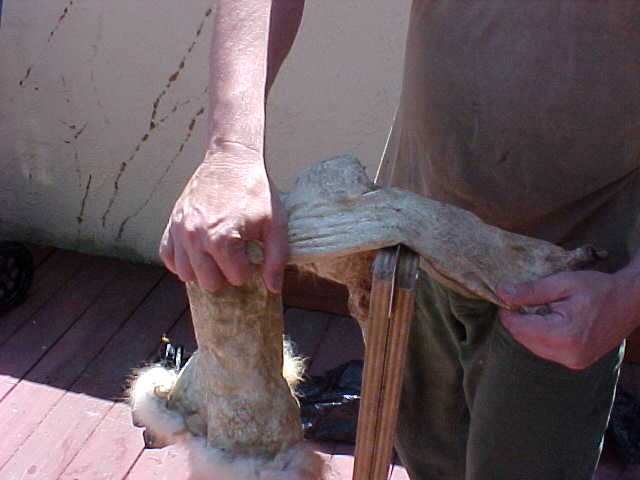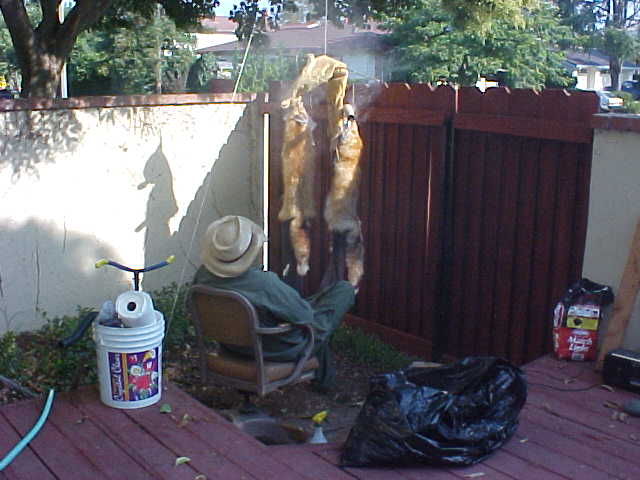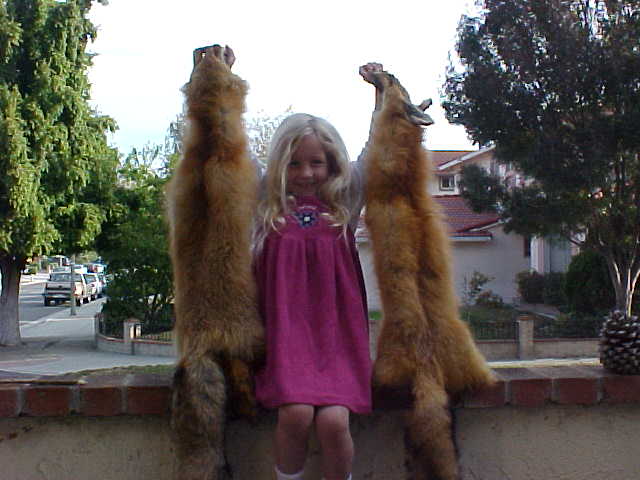
Urban Abo sounds like an oxymoron. A lot of us who like to practice primitive skills live in cities, have college degrees, hold regular jobs and careers. Maybe this is why primitive skills are so much fun for those of us who spend so much time inside factories and office buildings. In my own case, I'm a Midwestern farmer's son who married a city girl, works in the high tech industry and lives in a townhouse with a 10 X10 foot "yard" and a sundeck. I keep promising myself that someday we will be living in the country somewhere.
A lot of primitive skills can be practiced in back yards, sundecks, garages and living room couches, not necessarily in the woods or prairies. It takes a bit of imagination, and occasional foraging trips. Sometime the foraging take place in the urban places instead of the woods. After all a stick lying on the sidewalk can do the same job as a similar stick lying on a forest path. A lava rock found in the street will make a pretty good abrading tool.
My family in the Midwest has a lot of trappers and hunters so it is easy for me to get hides and furs. When I was back east to visit, I picked up some frozen furs and transported them frozen to my home and freezer in California. Fortunately, I have an understanding spouse who lets me keep frozen pelts in the freezer. Dried furs and rawhide are available from Moscow Hide and Fur. Fur bearing critters here in the bay area have really thin fur, and trappers are pretty much non-existent. A cold environment produces a much nicer fur.


Some of my tanning tools are rather nontraditional, for a very simple reason. It is what circumstances allow. I used to have two wooden scraping beams, but my wife gave me the order to "get them damn logs out of my flowers". So I figured that a couple of chunks of PCV pipe mounted over a garden rake will suffice, and I can disassemble and store them in the garage when not in use. If the critters skulls are not saved for me, pork brains are available from the local Asian supermarket. I can't build a campfire in my yard to cook the brains, but I can use an old fondue pot. I'm not allowed to dig a hole to smoke my pelts but an old flower pot and denim skirt will suffice. I used to haul all my stuff out to the country to tan, but these days I have a wife and 5-year-old daughter to consider. If I am working just outside the door, I can keep an eye on the child, or come inside if the need arises. The point is that in an urban environment, I have to make some adaptations to my very limited workspace, and to other people.
The basic steps to tanning furs are cleaning, braining, softening, and smoking. Each of these steps has a lot of detail, and I will try to explain them as best I can. There is more than one way to skin a cat, or to tan a hide, and this is what works for me. I took these photos while tanning two pelts, so some of the pics have both pelts, sometimes one.
The first step is to thaw the frozen pelt, and clean it up. Most fresh frozen hides have a bit of meat and fat on then. So I turned it inside out, and started scraping with my blade. This is an old planner blade with a couple of chunks of old radiator hoses for a handle. What I'm trying to do is to take off all the meat, fat, and membrane. The membrane is the most inside layer of the hide. It is very thin, a lot like a plastic wrap
If you don't get if off, the brain will not penetrate the skin, nor will the smoke. What I can't get with the blade, I will try to get off by abrading with a chunk of pumice stone or sandpaper. The torso of the fox goes easily, the head, legs and tail do not. Alcohol and paper towels work well for cleaning grease off hides. I don't know what was used traditionally to degrease pelts. Next the hide is buffed with an abrasive stone or sandpaper.


The ear cartilage I have approached two different ways. One pelt, I removed nearly all the cartilage entirely. The other pelt, I merely removed separated the back of the ear, leaving the cartilage attached to the inside of the ear. I don't know what is traditionally done, but I will see how the ears hold out in a few years. I use a couple of thin sticks and my fingers to separate the skin from the cartilage.

Canine hides are very thin, unlike some other critters. This means the skin can be easily damaged, so I must be gentle and cautious. Even so, I always get a few dings in the hide. Fortunately most breaks can be repaired, and from the outside, are not noticeable. The tail is a tiny strip of skin with a lot of fur hanging on it, so it probably can't be repaired easily. My very first fox hide I ruined the tail about halfway down.



Next step is the braining. I use a blender to mash up the brain and cook it in my old 1970s fondue pot. I think that fondue was one of the great things to come out of the 70s. My wife bought me a new fondue pot last Christmas. I think she got tired of the flower power motif. After the brain slurry is well cooked it should cool off until it is only warm. Too hot will cook the pelt; too cold will not penetrate the skin as well. The brains are rubbed into the skin, then the pelt is put into a plastic bag and in the shade. For the next two hours the pelt should be checked every half-hour. If it starts to smell too nasty, it is time to take it out of the bag and start softening.


Brains smell a little funny under the best of circumstances, and spoil quickly. Once my neighbor looked over the fence while I was working a hide and exclaimed, "What is that smell?" I make sure to clean up at the completion of the job. I wear old worn out clothing and a plastic apron. I don't mind if they get smelly, they can be discarded if need be. That GI T-shirt is going to fall apart one of these days.
Softening is a matter of manipulating the skin as it dries. This can be done a number of ways, stretching it over a stake, a cable, or between the hands. The hide changes color as it is stretched, turning paler as the fibers of the skin separate. Canine skins are very thin that must be stretched gently. Too rough and the skin will rip. If the stretching stops before the hide is COMPLETELY dry, the skin will revert back to the consistency of cardboard. I use a combination of stake and hand stretching. I have a portable stake as opposed to the traditional stationary stake, and a handheld deer bone chisel.

Now for the smoking. The idea is to smoke the skin side of the pelt, not the fur. Smoking a softened pelt will do a few important things. It will prevent the skin from turning hard after being wet. Smoking also discourages bugs. The color and smell it gives to the skin is a pleasant side effect, and also where the "tan" comes from. I use dry punky cottonwood; it gives a nice color. A friend of mine uses dried cow chips. I think my wife would get pretty upset if I tried to keep cow chips lying around, so I won't press my luck. A piece of string goes from the eyeholes to an overhead tree branch and keeps the hide in the right position. I have had a few folks on the sidewalk become concerned when they see smoke coming over the fence, but that is a good excuse to say good morning.


The ceramic pot has a coffee can inside and a couple of charcoal coals. To this I add handfuls of the punky wood. I keep the spritz bottle handy to dampen the jeans to prevent flare-ups. Paper towels plug up the small holes like the mouth, eyes, and front leg holes. A few sticks inside the hide will hold it open. I let it smoke until the color looks nice, usually about 2 hours. Smoking has to be watched without interruption, as a flare-up could ruin everything. I make sure to get all the personal comfort items taken care of before starting this job. If I have to leave it had better be an emergency and the hide/skirt gets hoisted off from the smudge until I return. The smoking is completed by bagging the hide for a couple of days to let the smoke set.
Now comes the really hard part, fashioning the pelts into usable clothing or blankets. Anyone out there ever make one of those hats that have the animal face at your forehead and the fur draping down your back like a cape? Give me a shout.

My thanks to Steven Edholm, Tamara Wilder, and George Michard, who set my feet on the path.
E-mail your commits to "Bill Scherer" at scherer_william@hotmail.com
We hope the information on the PrimitiveWays website is both instructional and enjoyable. Understand that no warranty or guarantee is included. We expect adults to act responsibly and children to be supervised by a responsible adult. If you use the information on this site to create your own projects or if you try techniques described on PrimitiveWays, behave in accordance with applicable laws, and think about the sustainability of natural resources. Using tools or techniques described on PrimitiveWays can be dangerous with exposure to heavy, sharp or pointed objects, fire, stone tools and hazards present in outdoor settings. Without proper care and caution, or if done incorrectly, there is a risk of property damage, personal injury or even death. So, be advised: Anyone using any information provided on the PrimitiveWays website assumes responsibility for using proper care and caution to protect property, the life, health and safety of himself or herself and all others. He or she expressly assumes all risk of harm or damage to all persons or property proximately caused by the use of this information.
© PrimitiveWays 2013